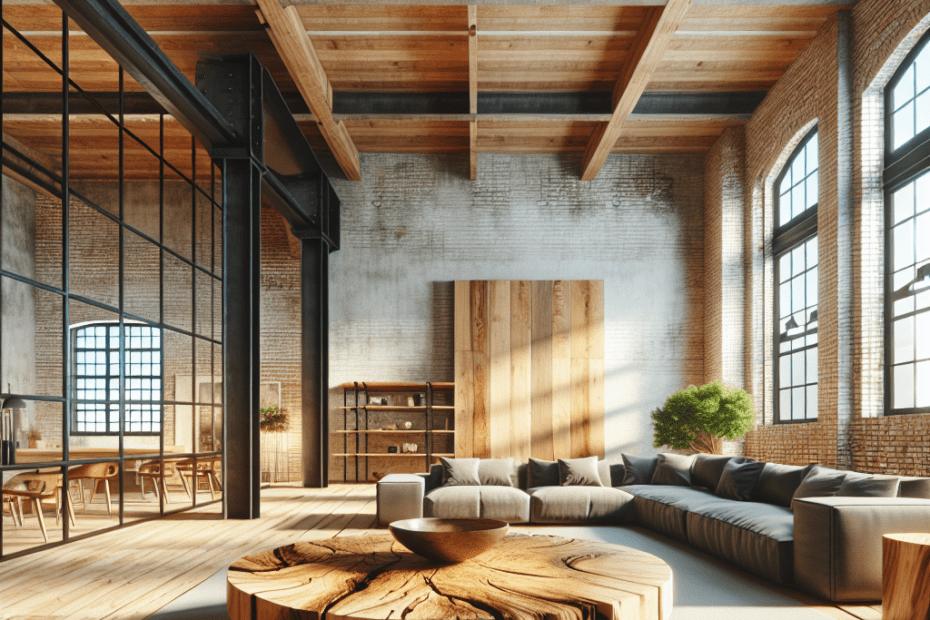“`html
The Essentials of Natural Wood Accents in Urban Industrial Interiors
Natural materials bring warmth and texture to urban spaces. Wood is a popular choice for enhancing industrial-style interiors. Designers and homeowners alike are increasingly integrating natural wood accents into their designs. These additions stand out against the stark, raw elements typical of industrial design, such as exposed brick, concrete, and steel. The synergy between wood and industrial materials creates a balanced aesthetic that feels both contemporary and inviting.
The Rise of Industrial Design
Industrial design became a prominent trend in the early 20th century, inspired by the exposure of materials and structures in urban settings. Now, it has spread across city apartments, lofts, and homes that embrace the raw, unpolished look. By definition, industrial design includes the use of exposed beams, large open spaces, and metal lighting fixtures. But recently, there’s been a shift towards softening these spaces with natural elements. This is where wood accents take the spotlight.
Enhancing Aesthetic Appeal with Wood
Wood accents add warmth and depth to industrial interiors. A Statista report states that the global market for wooden furniture reached a value of over USD 430 billion in 2021, showing a significant demand for wooden elements in interior spaces. By incorporating wood, people can add character to a room that feels otherwise cold and uninviting. The natural textures and grains of wood help to soften the industrial edge, creating a more balanced and cohesive environment.
Sustainable and Versatile
One key reason for the rise in popularity of wood accents is their sustainability. As an eco-friendly material, wood reduces carbon footprints compared to synthetic alternatives. Additionally, it offers versatility. Depending on the treatment, varnish, or finish, wood can blend seamlessly into various styles, from rustic to modern industrial.
Wood can appear in numerous forms—beams, floors, furniture, or smaller decorative pieces. Each one has the ability to transform an ordinary space into something extraordinary. A creatively placed wooden beam can divide a room, wooden floors can bring continuity, and wooden furniture adds functionality.
Practical Advantages of Wood Accents
Beyond aesthetics, wood enhances the functionality of industrial interiors. According to an American Wood Council report, wooden structures offer excellent insulation properties, which can contribute to energy efficiency. This natural material helps maintain comfortable temperatures year-round, reducing heating and cooling costs.
Durability is another factor. Quality wood pieces can withstand wear and tear, making them ideal for high-traffic urban environments. From sturdy tables to robust shelving units, wood can cater to both decorative and utility needs with ease.
| Wood Feature | Benefits |
|---|---|
| Beams | Structural support, aesthetic division |
| Floors | Continuity, warmth, durability |
| Furniture | Functionality, style, comfort |
Incorporating Wood with Other Materials
Industrial design thrives on blending materials. Incorporating natural wood with exposed brick enhances the raw beauty of the rustic elements. Combining wood with metal creates a contemporary yet vintage feel. By skillfully mixing these materials, they achieve a balance that highlights the strengths of each.
Lighting can play a crucial role in emphasizing wood accents. Using strategically placed lights can draw attention to wooden features, highlighting their unique textures and colors. The interplay of light and wood creates an inviting atmosphere, perfect for urban living spaces.
Key Takeaways
- Wood accents provide warmth and character to industrial interiors.
- They are sustainable, versatile, and can blend with various styles.
- Wood enhances insulation, energy efficiency, and durability.
- Effective integration involves balancing wood with materials like brick and metal.
- The market demand for wooden elements is significant and ever-growing.
FAQs
- Q: Why is wood popular in industrial design?
A: Wood adds warmth and texture, softening the starkness of industrial spaces. - Q: Is wood eco-friendly for interior design?
A: Yes, wood is sustainable and reduces carbon footprints compared to synthetic materials. - Q: How can wood accents improve energy efficiency?
A: Wood offers excellent insulation, helping maintain temperatures and reducing energy costs. - Q: What forms of wood are used in industrial interiors?
A: Forms include beams, floors, furniture, and decorative pieces. - Q: How can wood be combined with other materials in industrial design?
A: Wood pairs well with metals and bricks to create a balanced, cohesive aesthetic.
“`
